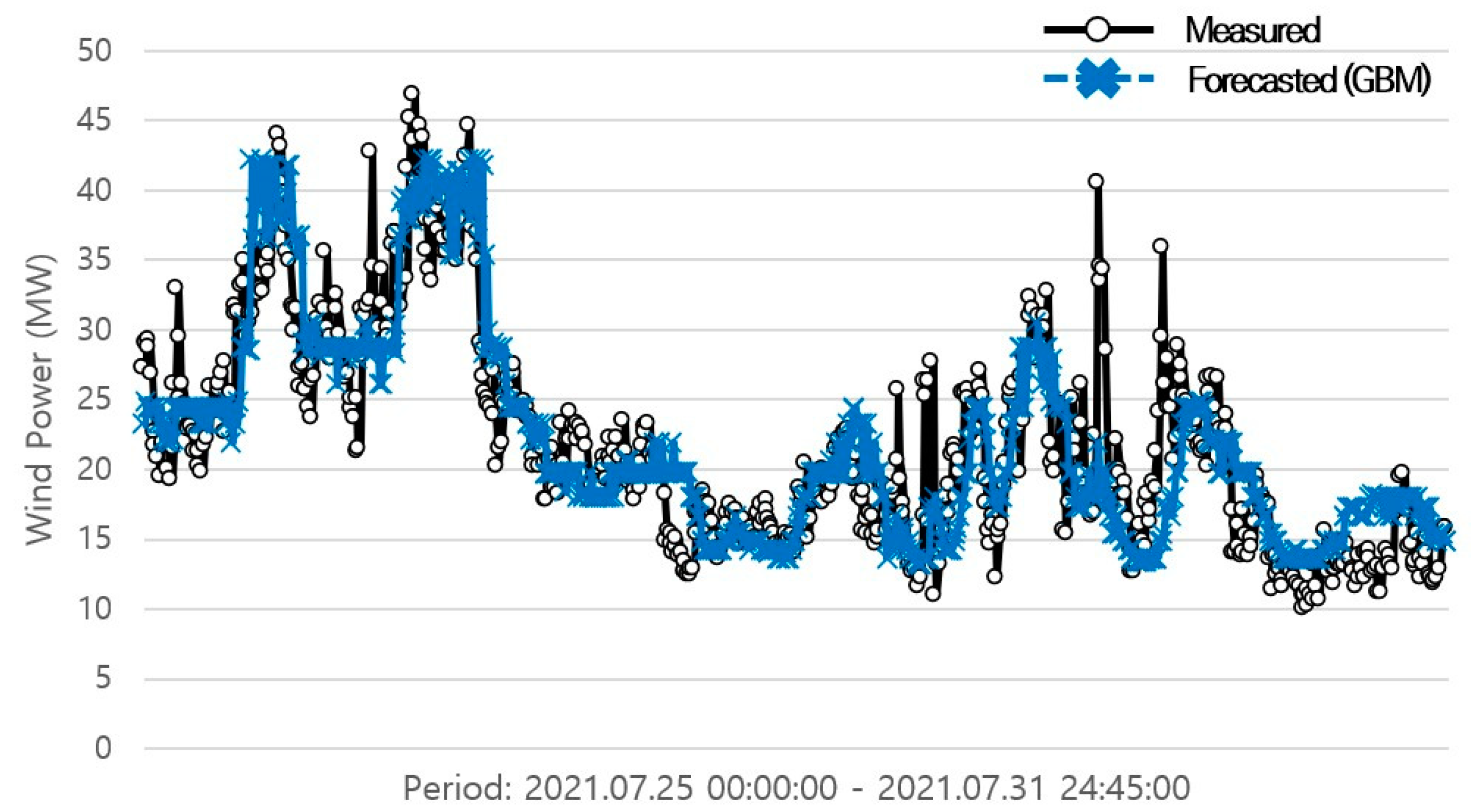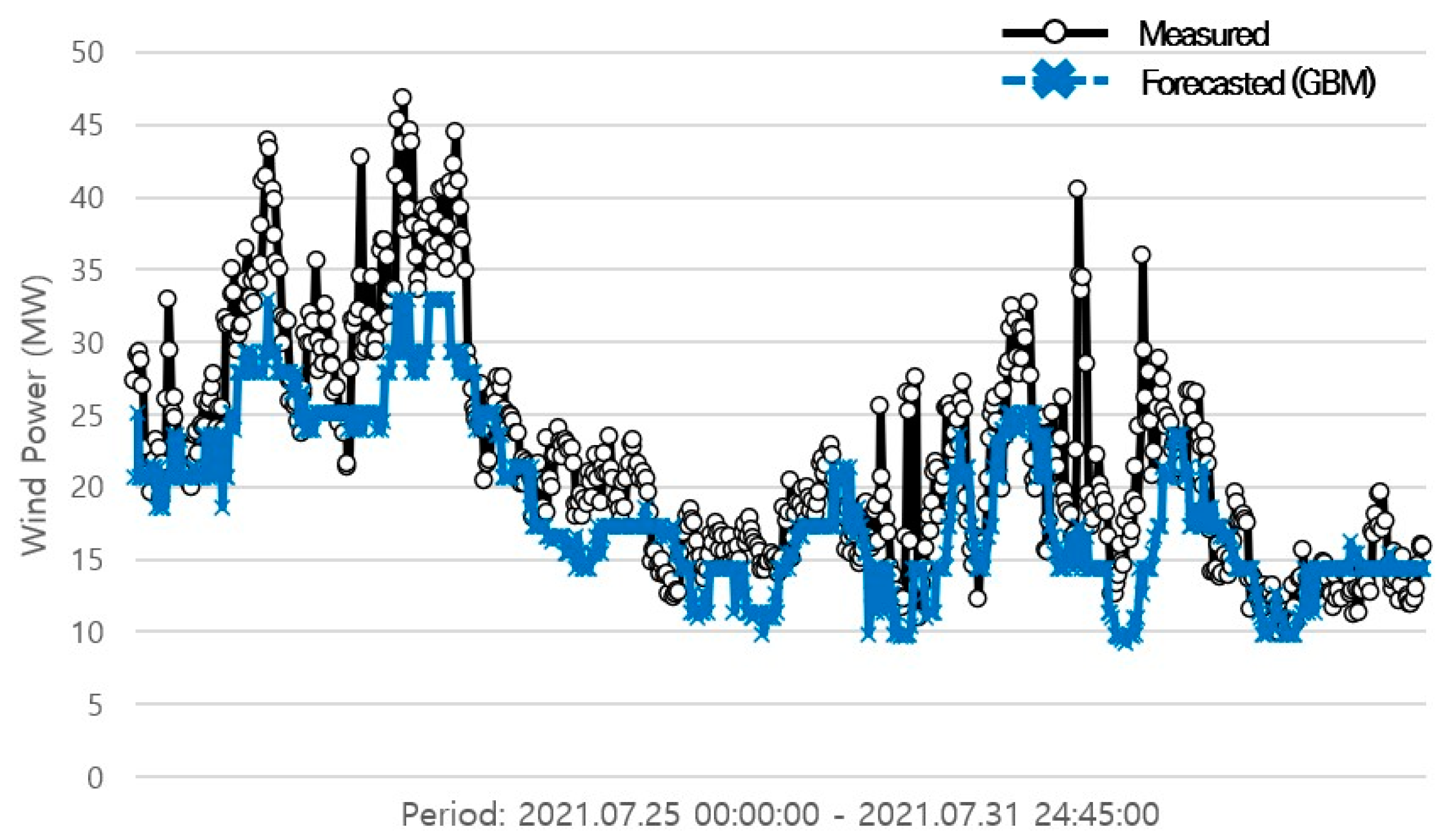A Short-Term Forecasting of Wind Power Outputs Based on Gradient Boosting Regression Tree Algorithms
Abstract
1. Introduction
2. Methodology
2.1. GBM Algorithm
2.2. Implementation of the Forecasting Model
2.2.1. Input Data and Data Splitting
2.2.2. Hyperparameters
- n.trees: number of trees;
- shrinkage: learning rate of the model;
- interaction.depth: maximum number for indicating the depth of individual trees;
- n. minobsinnode: represents the minimal number of observations in the terminal nodes of the trees;
- bag.fraction: fraction of the training-set data chosen randomly for individual trees to form the next tree;
- train.fraction: fraction of data employed to fit the GBM, while the rest check the loss function’s out-of-sample forecasts;
- cv.folds: number of cross-validations. Because the GBM model only included wind speed as a variable to predict wind power, the value of cv.folds was fixed at 1.
| Algorithm 1: Wind-power forecasting based on GBM algorithm | |||
| Input: 15 min interval data of Jeju Island | |||
| Data: wind speed (m/s) and wind power (MW) | |||
| 1 | Divide the training set and test set from the input data | ||
| 2 | for the test data do | ||
| 3 | select the last week (7 days) of the month | ||
| 4 | for the test data do | ||
| 5 | select the rest of the days of the month and seasons the test data are included | ||
| 6 | for each forecasting model | ||
| 7 | search for the optimal combination of the hyperparameters through the grid-search process | ||
| 8 | repeat for every forecasting model with different training datasets | ||
| 9 | until all the hyperparameter combinations in the grid are searched for | ||
| 10 | Insert the hyperparameters and train the GBM model | ||
| 11 | repeat | for every forecasting model with different training datasets | |
| 12 | until | all the forecasting-model forecasting results | |
| 13 | Evaluate the performance of the forecasting model by calculating the NMAE(%) value | ||
| end | |||
3. Results and Analysis
3.1. Results
3.1.1. Forecasting Results of the GBM Model
3.1.2. Analysis of Forecasting Results
3.2. Grid-Security Analysis
3.2.1. Application to Jeju’s Power System
3.2.2. Results of Grid-Security Analysis
4. Discussion
5. Conclusions
Author Contributions
Funding
Data Availability Statement
Acknowledgments
Conflicts of Interest
References
- 2050 Carbon Neutrality Commission. 2050 Carbon Neutrality Scenario; Secretariat of the 2050 Carbon Neutrality and Green Growth Commission: Sejong, Republic of Korea, 2021; pp. 20–32. [Google Scholar]
- IRENA. Renewable Energy Statistics 2022; International Renewable Energy Agency: Abu Dhabi, United Arab Emirates, 2022; pp. 26–27. [Google Scholar]
- Cho, Y.S.; Cho, S.M.; So, J.Y.; Ahn, J.K.; Lee, S.H.; Kim, K.H.; Cho, I.H.; Lim, D.O.; Kong, J.Y.; Kim, S.K.; et al. CFI 2030 Plan Amendment Supplement Service; Jeju Special Self-Governing Province: Jeju, Republic of Korea, 2019; p. 17. [Google Scholar]
- Barthelmie, R.J.; Pryor, S.C. Climate change mitigation potential of wind energy. Climate 2021, 9, 136. [Google Scholar] [CrossRef]
- IRENA. Future of Wind: Deployment, Investment, Technology, Grid Integration and Socio-Economic Aspects; A Global Energy Transformation paper; International Renewable Energy Agency: Abu Dhabi, United Arab Emirates, 2019; p. 21. [Google Scholar]
- National Disaster and Safety Portal. Available online: http://www.safekorea.go.kr/idsiSFK/neo/sfk/cs/sfc/acd/iflccwUserList.jsp?menuSeq=99 (accessed on 18 November 2022).
- Chen, Q.; Folly, K. Wind power forecasting. IFAC-PapersOnLine 2018, 51, 414–419. [Google Scholar] [CrossRef]
- Soman, S.S.; Zareipour, H.; Malik, O.; Mandal, P. A review of wind power and wind speed forecasting methods with different time horizons. In Proceedings of the North American power symposium 2010, Arlington, TX, USA, 26–28 September 2010; pp. 1–8. [Google Scholar]
- IRENA. Innovation landscape brief: Advanced forecasting of variable renewable power generation; International Renewable Energy Agency: Abu Dhabi, United Arab Emirates, 2020; pp. 6–11. [Google Scholar]
- Choi, J.-G.; Choi, H.-S. Prediction of Wind Power Generation using Deep Learnning. J. Korea Inst. Electron. Commun. Sci. 2021, 16, 329–338. [Google Scholar]
- Biswas, A.K.; Ahmed, S.I.; Bankefa, T.; Ranganathan, P.; Salehfar, H. Performance analysis of short and mid-term wind power prediction using ARIMA and hybrid models. In Proceedings of the 2021 IEEE Power and Energy Conference at Illinois (PECI), Urbana, IL, USA, 1–2 April 2021; pp. 1–7. [Google Scholar]
- Ahmadi, A.; Nabipour, M.; Mohammadi-Ivatloo, B.; Amani, A.M.; Rho, S.; Piran, M.J. Long-term wind power forecasting using tree-based learning algorithms. IEEE Access 2020, 8, 151511–151522. [Google Scholar] [CrossRef]
- Singh, U.; Rizwan, M.; Alaraj, M.; Alsaidan, I. A machine learning-based gradient boosting regression approach for wind power production forecasting: A step towards smart grid environments. Energies 2021, 14, 5196. [Google Scholar] [CrossRef]
- Bankefa, T.; Biswas, A.K.; Ranganathan, P. Hybrid Machine Learning Models for Accurate Onshore/Offshore Wind Farm Forecasts. In Proceedings of the 2022 IEEE International Conference on Electro Information Technology (eIT), Mankato, MN, USA, 19–21 May 2022; pp. 335–341. [Google Scholar]
- Kuhn, M.; Johnson, K. Applied Predictive Modeling; Springer: Berlin/Heidelberg, Germany, 2013; Volume 26, pp. 203–206. [Google Scholar]
- Dhiman, H.S.; Deb, D.; Balas, V.E. Supervised Machine Learning in Wind Forecasting and Ramp Event Prediction; Academic Press: Cambridge, MA, USA, 2020; pp. 67–69. [Google Scholar]
- Natekin, A.; Knoll, A. Gradient boosting machines, a tutorial. Front. Neurorobotics 2013, 7, 21. [Google Scholar] [CrossRef] [PubMed]
- Hastie, T.; Tibshirani, R.; Friedman, J.H.; Friedman, J.H. The elements of statistical learning: Data mining, inference, and prediction; Springer: Berlin/Heidelberg, Germany, 2009; Volume 2, pp. 359–361. [Google Scholar]
- Greenwell, B.; Boehmke, B.; Cunningham, J.; Developers, G.; Greenwell, M.B. Package ‘gbm’. R package version 2022, 2.1.8.1. 2022, pp. 6–8. Available online: https://cran.r-project.org/web/packages/gbm/gbm.pdf (accessed on 27 November 2022).
- Korea Power Exchange (KPX). Available online: https://der.kmos.kr/intro/fr_intro_view10.do (accessed on 27 December 2022).
- Korea Electric Power Corporation (KEPCO) Marketing Division. Korea Electric Power Corporation (KEPCO). Available online: https://cyber.kepco.co.kr/ckepco/front/jsp/CY/D/C/CYDCHP00403.jsp (accessed on 27 November 2022).




| Max | Mean | Min | STD | |
|---|---|---|---|---|
| Wind speed (m/s) | 17.52 | 4.8820 | 0.48 | 2.4914 |
| Wind power (MW) | 69.6412 | 22.8395 | 0 | 13.9475 |
| Month | Training Set | Test Set |
|---|---|---|
| July | 07. 01–07. 24 | 07. 25–07. 31 |
| Season | Training Set | Test Set |
|---|---|---|
| Summer | 06. 01–06. 23 07. 01–07. 24 08. 01–08. 24 | 07. 25–07. 31 |
| Previous Month | Training Set | Test Set |
|---|---|---|
| June | 06. 01–06. 30 | 07. 25–07. 31 |
| GBM Model | n.trees | shrinkage | interaction.depth | n.minobsinnode | bag. fraction |
|---|---|---|---|---|---|
| GBM model trained by month | 226 | 0.1 | 1 | 5 | 0.65 |
| GBM model trained by season | 67 | 0.1 | 1 | 15 | 0.65 |
| GBM model trained by the previous month | 13 | 0.3 | 3 | 15 | 0.65 |
| Training Set | NMAE (%) | MAE (MW) | RMSE (MW) | |
|---|---|---|---|---|
| Model trained by month | 07. 01–07. 24 | 5.1507% | 3.0904 | 4.1116 |
| Model trained by season | 06. 01–06. 23 07. 01–07. 24 08. 01–08. 24 | 5.1933% | 3.1160 | 4.1657 |
| Model trained by the previous month | 06. 01–06. 30 | 6.9334% | 4.1601 | 5.4348 |
| Training Set | Test Set | NMAE (%) | MAE (MW) | RMSE (MW) | ||||
|---|---|---|---|---|---|---|---|---|
| LSTM | GBM | LSTM | GBM | LSTM | GBM | |||
| Model trained by month | 07. 01–07. 24 | 07. 25 | 7.5667 | 5.5354 | 4.5400 | 3.3212 | 5.2518 | 4.1587 |
| 07. 01–07. 24 | 07. 25–07. 26 | 10.2290 | 5.8716 | 6.1374 | 3.5230 | 7.9060 | 4.4570 | |
| Model trained by season | 06. 01–06. 23 07. 01–07. 24 08. 01–08. 24 | 07. 25 | 13.6782 | 4.7157 | 8.2069 | 2.8294 | 9.4568 | 3.6257 |
| 06. 01–06. 23 07. 01–07. 24 08. 01–08. 24 | 07. 25–07. 26 | 11.6396 | 5.4958 | 6.9837 | 3.2975 | 8.8772 | 4.2343 | |
| Case | Applied Data | Period of Data | Forecasted Wind Power (MW) |
|---|---|---|---|
| Case #1 | Maximum wind-power forecast of the monthly trained model during on-peak | 26 July 2021 18:30 | 42.1144 |
| Case #2 | Maximum wind-power forecast of the seasonally trained model during on-peak | 26 July 2021 16:00 26 July 2021 16:15 26 July 2021 16:30 26 July 2021 16:45 | 36.4871 |
| Case #3 | Average wind power of the monthly trained model during -peak | On-peak period of the test set | 25.596 |
| Case #4 | Average wind power of the seasonally trained model during on-peak | On-peak period of the test set | 23.8444 |
| Performance | Case #1 | Case #2 | Case #3 | Case #4 |
|---|---|---|---|---|
| Low-voltage range violations | 0 | 0 | 0 | 0 |
| High-voltage range violations | 148 | 0 | 0 | 0 |
| Flow violations | 1 | 1 | 1 | 1 |
| Non-converged contingencies | 0 | 0 | 0 | 0 |
Disclaimer/Publisher’s Note: The statements, opinions and data contained in all publications are solely those of the individual author(s) and contributor(s) and not of MDPI and/or the editor(s). MDPI and/or the editor(s) disclaim responsibility for any injury to people or property resulting from any ideas, methods, instructions or products referred to in the content. |
© 2023 by the authors. Licensee MDPI, Basel, Switzerland. This article is an open access article distributed under the terms and conditions of the Creative Commons Attribution (CC BY) license (https://creativecommons.org/licenses/by/4.0/).
Share and Cite
Park, S.; Jung, S.; Lee, J.; Hur, J. A Short-Term Forecasting of Wind Power Outputs Based on Gradient Boosting Regression Tree Algorithms. Energies 2023, 16, 1132. https://doi.org/10.3390/en16031132
Park S, Jung S, Lee J, Hur J. A Short-Term Forecasting of Wind Power Outputs Based on Gradient Boosting Regression Tree Algorithms. Energies. 2023; 16(3):1132. https://doi.org/10.3390/en16031132
Chicago/Turabian StylePark, Soyoung, Solyoung Jung, Jaegul Lee, and Jin Hur. 2023. "A Short-Term Forecasting of Wind Power Outputs Based on Gradient Boosting Regression Tree Algorithms" Energies 16, no. 3: 1132. https://doi.org/10.3390/en16031132
APA StylePark, S., Jung, S., Lee, J., & Hur, J. (2023). A Short-Term Forecasting of Wind Power Outputs Based on Gradient Boosting Regression Tree Algorithms. Energies, 16(3), 1132. https://doi.org/10.3390/en16031132






